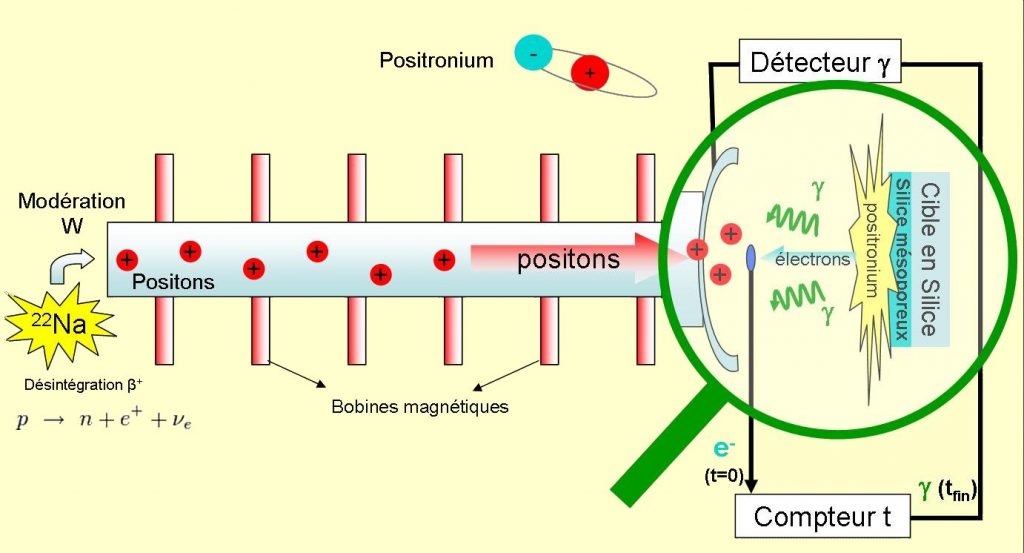L. Liszkay1, C. Corbel1, P. Perez1, P. Desgardin2, M.-F. Barthe2, T. Ohdaira3, R. Suzuki3, P. Crivelli4, U. Gendotti4, A. Rubbia4, M. Etienne5, and A. Walcarius5
1DSM/IRFU and IRAMIS, CEA Saclay F-91191 Gif-sur-Yvette Cedex, France
2CNRS-CERI, 3A Rue de la Férollerie, F-45071 Orléans Cedex 2, France
3AIST, Tsukuba, Ibaraki 305-8568, Japan
4Institut für Teilchenphysik, ETHZ, CH-8093 Zürich, Switzerland
5LCPME, CNRS-Nancy-Université, 405 Rue de Vandoeuvre, F-54600 Villers-lès-Nancy, France
The positronium (Ps) is a bound state between an electron and its antiparticle, the positron. Producing clouds of positronium atoms in vacuum is a first condition to achieve new types of experiments in fundamental physics of gravity and antimatter. It also offers significant interest as a probe of porous materials at the nanometric scale. A unique collaboration involving among other, physicists from IRFU and IRAMIS at CEA-Saclay has been able to put the positronium production to a record level in stable and controlled conditions [1]. This is an important step for the program to test the gravity of antimatter.

The principle of equivalence between the inertial mass and the gravitational mass, which is at the heart of the general relativity, has never been directly verified with antimatter. The “weak” equivalence principle said that the trajectory of a particle test is independent of its internal structure and composition. But in quantum theory, some models contain non-traditional gravitational components, leading to an acceleration of antimatter different than for the matter, in a gravitational field like that of the Earth.
Projects to measure the free fall of charged particles of antimatter, like positron or antiproton, require shielding against surrounding electromagnetic fields with an efficiency that could not be reached. Also current projects aim to use neutral atoms of antimatter, but comes the slowdown problem as they must be produced at very low speed to be able to measure their fall within a reasonably sized apparatus.
The IRFU project is to produce antihydrogen by making the CERN slow antiproton beam interacting with positronium atoms (Ps), an electron-positron bounded system. Positronium atoms are produced by implation of positrons in a material where they bound to electrons of the lattice. In a first step, the optimization of the efficiency of this conversion is the subject of collaboration between the DSM/IRFU/SPP, the DSM/IRAMIS/LSI and the CNRS/CERI (Orléans), AIST (Tsukuba), the ETHZ (Zurich) and LCPME (Nancy).


For this study, an original equipment has been installed in CERN on a positron beam emitted by a sodium-22 source. The positrons are spontaneously emitted by β+ (p → n + e+ + νe) radioactivity emission, slowed down and brought with an energy of a few keV to the target (Figure 1). A device to measure the life time of the positronium has been mounted in the vicinity of the target: a counter-timer starts after detection of one electron issued upon arrival of one positron at the target and stops after the detection of a gamma ray emitted upon the annihilation of Ps, by a detector with a large angular acceptance. In addition, this allows to directly measure the positronium re-emission rate in solid targets. One measure in that way the reflectance, as Ps atoms are emitted in vacuum towards the slow positron incident beam. The target is made up of a silica mesoporous film (with cavities at the nanoscale), a material derived from silica powders, in which the formation of Ps has been discovered in the 60’s by a physicist of Saclay. [2].

Each measurement of the lifetime of positronium is repeated over several million annihilations. The spectrometer was designed to detect the three photons annihilation mode of the positronium ortho state, o-Ps. The measured life time are distributed according to an exponential law, which slope in logarithmic scale gives the well-known lifetime of 142 ns (Figure 2). The measure of a strictly monotone exponential decay (compared to the measure with the porous layer of the laboratory of Nancy) also shows the quality of the positronium emission.
This experiment shows that the deposition of a silica mesoporous film on a silicon substrate allows reaching a yield of 40% (Figure 3). This is the first time that such a performance with this material is observed in a direct measurement. It is observed that the yield highly depends of the conditions of fabrication of the film, determining the density, distribution and interconnection of the pores. Moreover, the measured yield is for o-Ps atoms that are emitted at low energy by the porous medium, which is being sought for the subsequent production of antihydrogen.

With this equipment, it was possible to quantify for the first time the yield of Ps reemission and to compare in a reliable way the performance of different targets. This will allow to better design the target to rech high yields of Ps emission and to check if other mesoporous materials may have higher yields than those based on silica. This will also allows to assess how aging affects the target efficiency, in the absence of irradiation as well as in presence of the intense incident positron beam.
Beyond the initial interest of this result for producing antihydrogen, the study of mesoporous films based on silica has potential applications in industry semiconductors, for chemical sensors or nanoporous filters. For example one of the properties of these films is to have a smaller dielectric constant, which gives them a capacitance lower than those usually used silica, and make it a material of choice for the design of faster electronic circuits.
Contacts :
Laszlo Liszkay, Irfu/SACM
Catherine Corbel, Iramis/LSI

[1] L. Liszkay et al., Positronium reemission yield from mesostructured silica films, Appl. Phys. Lett. 92 (2008) 063114.
[2] R. Paulin and G. Ambrosino, Annihilation libre de l’ortho-positonium formé dans certaines poudres de grande surface spécifique, J. Phys. France 29, 263-270 (1968).

